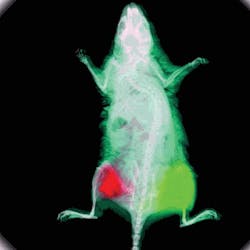FLUORESCENCE IMAGING: Microscopy method measures mingling microbes

A new microscopy method that reveals what types of bacteria mingle with each other in microbial communities holds promise as a diagnostic tool. The technique, combinatorial labeling and spectral imaging fluorescent in situ hybridization (CLASI-FISH), identifies microbes in a community much faster than conventional laboratory culturing or DNA sequencing. It also reveals the three-dimensional spatial organization of microbial communities, a task beyond those other methods. “We get information on the presence of many different microbes at once and get it quickly, cheaply, and perhaps more accurately than other methods,” says Gary Borisy, president and director of the Marine Biological Laboratory (MBL) in Woods Hole, MA, who supervised the research that led to the technique.
The method has potential value because many clinical microbiologists are challenging the idea that a single type of pathogen causes disease. “There is strong evidence that a number of different microbes are associated with periodontal disease, but these microbes are also found in disease-free individuals,” says Alex Valm, a Ph.D. student in the Brown-MBL Graduate Program in Biological and Environmental Studies, who developed the method. “Since the microbes are known to form multi-species structures and there is evidence in other systems that bacteria cooperate with each other to compete for resources, the structure of the community might have more relevance for a clinical diagnosis than simply a test for what organisms are present in an individual.”
The FISH component of the technique is well established, although the MBL team applied some cutting-edge technology in the form of two laser scanning confocal microscopes—a Nikon C1SI initially and then a Zeiss 710. What the MBL team pioneered was the method of labeling microbes.
“The core of the technology is the ability to label different microbes with reporter fluorescent dyes,” Valm explains. Current labeling techniques allow researchers to differentiate among no more than five types of microbe. “What’s new,” says team member Jessica Mark Welch, “is the ability to use 16 fluorophores and get up to 120 combinations.” The process involves adding fluorophore-conjugated oligonucleotide probes to a sample of fixed microbes in such a way that each kind of microbe is labeled with two different fluorophores. The effect seen in the microscope resembles an artists’ palette.
As a proof of concept experiment, the team applied its labeling technique to identify 28 different types of Escherichia coli. Then they used the approach to analyze dental plaque, a well-studied biofilm that contains at least 600 microbe species. Floyd Dewhirst of the Harvard School of Dental Medicine supplied a database that included the nucleic acid sequence data on those microbes. “We designed probes at the genus level,” Valm recalls. “We had 15 different probes covering more than 50 percent of the bacteria we expected to find.”
Not only did the team identify the bacteria in their plaque samples, they were able to locate them and their near neighbors precisely. Two types—Prevotella and Actinomyces—turned out to associate with each other most frequently. “This might imply some functional interaction between them,” Borisy says. “One may be facilitating the other to colonize the site, and the exchange will reap some benefit for them both.”
Expansion of the research
Welch is now leading a joint project with Washington University, St. Louis to apply CLASI-FISH to identify groups of microbes in the guts of designer mice that harbor human microbes. “We’re investigating the mice’s response to the introduction of new bacteria,” she says.
The approach is not limited to microbes. “The approach could be useful for the analysis of spatiotemporal arrangements of complex biological structures such as cellular organelles and macromolecular assemblies within cells, allowing the precise microscopic analysis of many dynamic biological complexes,” the team writes in Proceedings of the National Academy of Sciences.
Borisy outlines the hope for the technology. “It’s very possible that it will enable a new kind of clinical diagnostic procedure, so that it will be possible to very quickly and accurately diagnose a specimen for many kinds of microbes at once,” he says. “As an alternative to culturing it could be faster, cheaper, and better.”
About the Author
Peter Gwynne
Freelance writer
Peter Gwynne is a freelance writer based in Massachusetts; e-mail: [email protected].